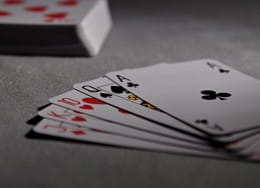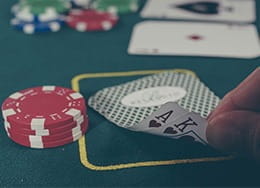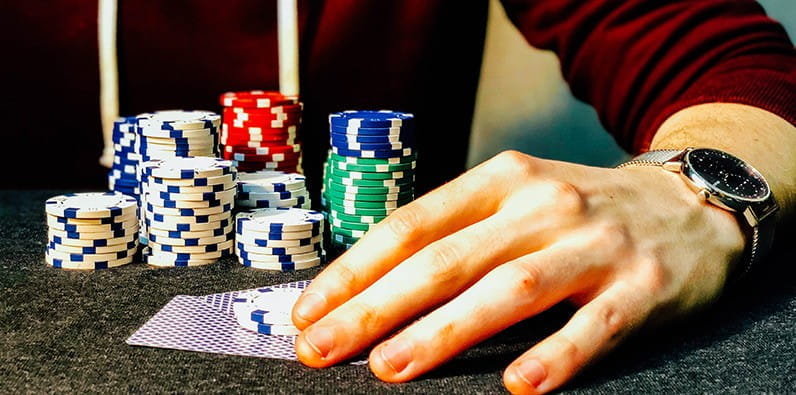Being able to spot poker tells is a huge advantage and there are many tips about how to do it both when playing online and at a live table. In the following article, we will list 15 poker tells at a real live poker table. In case you prefer online play, you can check out the best poker sites in the UK and start playing in some of the biggest poker platforms in the world. Checking out our valuable tips will definitely give an upgrade to your poker skills and will help you take advantage of the amateur players a lot more.
1. Your Chips Tell More Than You Think!
Sitting on the table and taking care of your stack is very important for the most detail-oriented players. No matter the starting amount, if a player is neatly arranging his chips, it means that he is playing tight and his range of hands may not be as wide. On the opposite, if a player’s stack of chips is sloppy or splashed, it may mean that he is more aggressive and tends to bluff more often. Such tells may be viable for you when it comes to minor adjustments of your poker strategy.
Another tell from this category is when somebody splashes the pot while making a bet with an aggressive throw of their chips. In most cases, this is a tell for a weak hand, and the aggressor is trying to scare you so you can fold. It is good to have those in mind, so you can have the edge over the players around you!
One widespread tactic is to test your opponent with your chips. If you’re suspicious about the person before you, just grab some chips almost at the same time as when he is planning to make a bet. When he sees that, If he has a strong hand, he will likely make a bet, without any hesitance, faster than usual. If he is bluffing, or his hand is weak, he will most likely hesitate and take his time before committing an amount to the pot. This way you will know how to act and who knows, maybe you can even steal the pot!
2. Behaviour When Buying in
It is not necessary to start the game to witness a weakness. How a player buys into the game can tell you a lot about their style of play and whether they will be bluffing a lot or not. Normally, ‘tight’ players will be quiet and won’t draw a lot of attention when they buy-in. They will take their chips and take a seat on the table, without any pointless talks. Aggressive players will talk loudly, try to draw attention to themselves and flash the money, intended for the buy-in.
3. Body Language
 The cards have been dealt and there is some pre-flop action – a mini-raise, followed by a 4-bet, and after everybody calls, you all get to see a flop. Suddenly, you notice that the person who made the 4-bet is leaning towards the table. It looks strange, doesn’t it? People, who tend to like the flop or their hole cards, usually lean towards the table. It’s a pretty safe way to assume that this person likes his chances and has a solid hand. On the opposite side, if a player is leaning back, staring in space, without showing any interest in what is happening on the table, it’s usually a tell for a weak hand and the person will most probably fold after somebody makes a bet.
The cards have been dealt and there is some pre-flop action – a mini-raise, followed by a 4-bet, and after everybody calls, you all get to see a flop. Suddenly, you notice that the person who made the 4-bet is leaning towards the table. It looks strange, doesn’t it? People, who tend to like the flop or their hole cards, usually lean towards the table. It’s a pretty safe way to assume that this person likes his chances and has a solid hand. On the opposite side, if a player is leaning back, staring in space, without showing any interest in what is happening on the table, it’s usually a tell for a weak hand and the person will most probably fold after somebody makes a bet.
4. Shaky Hands
Controlling your emotions is not as easy as it sounds. Even if a player thinks he can control his movements and reactions in a nervous situation, that is not always the case. It is human nature. Often when a person feels tense and agitated, his hands or fingers start to shake. Players who know this is one of their weaknesses often hold their hands on their lap, bellow the edge of the poker table. Every once in while they forget to hide this disadvantage and you are able to see how their fingers shiver. More often than not, this shows strength and the player in mind probably has hit the card that makes his hand either ‘the nuts’ or the second-best hand.
5. Movements Under the Table
Except the poker tells that you can extract above the table, from the eyes and face of the opposing players, plenty of moves can happen under the table. If you see a player who is moving or tapping their feet during a hand they’re into, this usually tells you that they are either very strong or very weak. Players that appear calm above the table, but are tapping and moving their feet, usually means that they cannot totally contain their excitement and have a very strong hand. Players that appear very strong and aggressive above the table, but can’t completely handle the anxiety and it leaks through their feet, usually have weak hands and are bluffing.
6. When Nerves Speak Louder Than Actions
When you spot someone who acts nervous, you know that something is not right. One thing is for sure – in most situations, he doesn’t have a mediocre hand. Usually, this is a tell for a strong hand. Nerves are a way of relieving the pressure and are also an expression of high adrenaline at the poker table. However, there’s a flip side to that coin ( or should we call it a chip ? ). Another common tell is when a player makes a bet and splashes the pot unintentionally and nervously tries to put his chips together. In most cases, this is a sign of a weak hand, so keep an eye on how your opponents are placing their bets.
7. How Are You Looking At Your Hole Cards?
Reading poker tells is never easy and this one definitely requires attention to detail. If you haven’t thought about this, you are definitely missing out on a valuable poker tell! People who look at their hole cards and stare at them for a bit, either have nothing or don’t like their cards. If you have “the nuts”, you’ll remember that for sure. A good piece of advice we can give you is always to memorise your hole cards and never check them during a game, as this might give out information to your opponents.
8. Position of Hole Cards
 You should always pay attention to the position and placement of your opponents’ hole cards. A common rule in the land-based poker rooms is the ‘hole cards to be visible at all times’, as well as ‘ every player is responsible for the protection of his hole cards’. Usually, when a player is placing his cards behind the stack means his hole cards are good. Another common habit of the poker players is putting a single chip on top of the hole cards. If you witness that kind of routine, then whenever the player is not doing it straight away after seeing the cards means that they are not good enough and he will fold them when is his turn to act.
You should always pay attention to the position and placement of your opponents’ hole cards. A common rule in the land-based poker rooms is the ‘hole cards to be visible at all times’, as well as ‘ every player is responsible for the protection of his hole cards’. Usually, when a player is placing his cards behind the stack means his hole cards are good. Another common habit of the poker players is putting a single chip on top of the hole cards. If you witness that kind of routine, then whenever the player is not doing it straight away after seeing the cards means that they are not good enough and he will fold them when is his turn to act.
9. Weak Means Strong and Strong Means Weak
A common style of play of the more inexperienced players is trying to look weak when they have a strong hand. Trying to look like the decision to make a bet or a call is a hard one and perhaps use weak language like ‘I guess I will call’ or make some kind of a sad noise usually means the player is ‘on fire’ and just wants to ‘trap’ you. Players who make a bet and intentionally turn their eyes off the table right away, as they are distracted or disinterested of the results, generally will have a powerful hand. Be cautious and always observe the details!
10. Bet and Call Speed – Are You on a Draw?
You’ve flopped a top pair, you make a bet and your opponent calls immediately. You notice there are two spades on the board and a straight possibility. The turn is a “brick”, you bet again and you get insta-called. Most probably your opponent is waiting for a flush or a straight. Players tend to call fast when they are on a draw, so you can take advantage of that. If you are convinced you have them beat and they miss their draw, you can place a pot-size bet which will polarise your range. In this case, they’ll either fold or re-raise with a bluff, depending on how much chips they’ve committed to the pot. If they do re-raise you, you’ll extract some extra cash by calling their bluff, so make sure to take advantage in those situations.
11. Sunglasses
 As they say, eyes are the windows to your soul. They are believed to give a lot of information on your mood, intentions, etc. That is why a lot of poker players wear sunglasses on the tables. Most of the times these players know that their eyes can be ‘a weak spot’ and try to hide them. Every once in a while, they will take the sunglasses off. If it is during a hand, then most likely they are not interested in the pot and will fold as soon as is their turn to act.
As they say, eyes are the windows to your soul. They are believed to give a lot of information on your mood, intentions, etc. That is why a lot of poker players wear sunglasses on the tables. Most of the times these players know that their eyes can be ‘a weak spot’ and try to hide them. Every once in a while, they will take the sunglasses off. If it is during a hand, then most likely they are not interested in the pot and will fold as soon as is their turn to act.
12. Jibber Jabber
Whenever you are in a hand and another player is speaking a lot of gibberish, that usually means they are nervous and have the intention to bluff. Some good professional poker players have developed this quality in order to start easy conversations with their opponents, with the purpose to extract a poker tell. If you ask an opponent a simple question like ‘What’s the weather like?’ and they start to babble and give you an answer that makes absolutely no sense, that means they have a weak hand and are most likely bluffing.
13. Speaking to the Dealer
Whenever a player tries to start a conversation with the dealer, during a hand, he is participating in, that often means that he has a weak hand or he is on a draw. Asking for a particular card seems a bit too obvious, but more often than not the particular player is indeed waiting for some kind of a draw. If the mentioned card does come up, the player will have a strong foundation to bluff.
14. Blind Bets
Players who place blind bets when they are on the UTG position (first to act), usually are on a draw and they use this method as some kind of a protection bet, trying to limit the pot. Using this method frequently may mean that it is part of the style of the player, but if you see someone who doesn’t do it often, it usually means that they are not very strong and just try to scare off the competition.
15. Smiles
 If you are able to spot the difference between a real and a fake smile, then you will be able to gain some useful information about your opponent’s cards. A player with a strong hand is capable of smiling deeply and sincerely, smiling insincerely or not smiling at all.
If you are able to spot the difference between a real and a fake smile, then you will be able to gain some useful information about your opponent’s cards. A player with a strong hand is capable of smiling deeply and sincerely, smiling insincerely or not smiling at all.
On the other hand, a bluffer will usually find it difficult to demonstrate a sincere and honest smile. Real smiles are involving the muscles of the eyes, are more symmetrical and include more of the mouth than a fake pretended smile.
Constantly Improving Your Reading Abilities!
If there’s one thing you should always remember about poker, is that you can never have this game figured out. Constant practice and improving your skills are essential for your further development as a poker player. There are some courses like Daniel Negreanu’s masterclass which can also come in handy. Reading books about poker psychology is also a good way to help yourself, but whatever you do… observe carefully, take your time, and remember, that even the smallest details can win you the biggest pots!



